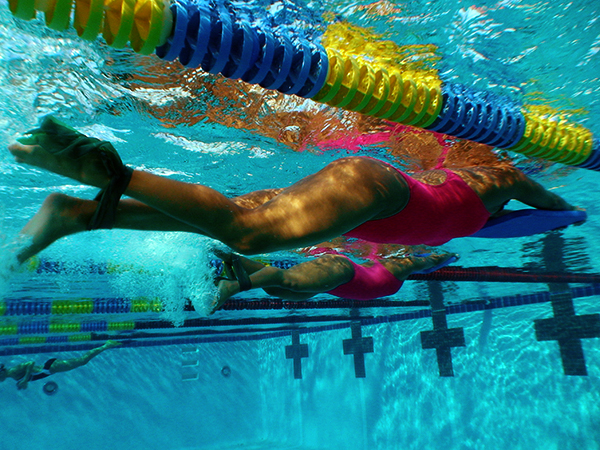Kicking is not only for propulsion

A good swim, unlike the bike or run, is much more dependent on upper body strength to generate propulsive power. Nonetheless, the kick is extremely important for fast swimming. At the Race Club camps, I usually find that most swimmers do not condition their legs as well as they should, nor do they often appreciate the importance of their kick in the overall swimming speed. Part of the reason for that is that most swimmers think of the legs as only providing some propulsion…and not much at that. The reality is that the kick actually serves four different functions in the swimming stroke; propulsion, lift, stabilizing force, and sustain speed (inertia). All four are important.
Let’s start with propulsion. One of the great enigmas for the non-swimmer triathlete is how the good swimmer kicks so fast. After all, it is not as if the runner/cyclist does not have strong legs. To flutter kick fast requires more than strong legs and core. Great ankle flexibility is also required and hyperextension of the knees is important. A bigger foot size helps, but it’s not as important as one might think and less so than the previous two factors. Finally, conditioning of the legs to maintain a continuous fast, tight kick in both up and down directions is critical to fast kicking (explanatory video here).
Second is lift. Lift is important in order to reduce frontal drag, and frontal drag is the number one enemy of the swimmer. We certainly know from our wetsuit experience that getting just a few millimeters higher in the water can reduce drag significantly and increase our overall speed. One doesn’t necessarily have to get a lot of propulsion from the legs in order to get significant lift. Even a two-beat kick can provide important lift for the swimmer (video here).
Third is the stabilizing force. Whether using a two-beat or a six-beat kick, the strongest (or only) kick comes at the completion of the arm pull on the same side. Since the body should be rotating in order to maximize efficiency, that big kick actually occurs somewhat to the side rather than straight down. That big kick also completes a counter-rotation of the entire body that is initiated with the hip/core/shoulders at the same time that the underwater arm pull begins (the "catch"). This initial motion, which generates a force against which we can pull our hand/arm more efficiently, is called the connection between our arm and core. This same stabilizing force that began with our arm in the front quadrant and the hip changing directions, ends with a strong kick to the side. By this time, the hand/forearm have reached the very end of the propulsive phase, so the kick helps keep the stabilizing force in effect longer, enabling us to milk every bit of propulsion possible from our underwater pull. The faster and longer the hip-turn and the harder that big kick is, the greater the stabilizing force becomes and the more distance per stroke we can generate (video here).
Finally, consider inertia. A two-beat kick doesn’t help here. But a six-beat kick that generates six propulsive movements for every arm stroke (3 up kicks and 3 down kicks) may not produce as much propulsion from each kick, but it produces a lot more of them and much more often. The result is that a good six-beat kick can help sustain your speed closer to constant. Just like driving your car in stop-and-go traffic, swimming by slowing down and speeding up with every arm stroke is a much less efficient way to move through the water. While it’s debatable whether cycling requires pulling up as well as pushing down on the pedal, sustaining constant speed in swimming does require kicking with some force in both directions (video here).
Does knowing all this about your kick help you figure out how to be a better swimmer? Perhaps. A better triathlete? Perhaps not. If you were merely trying to be a faster swimmer, I would encourage you all to work your legs more and unless you could learn to turn over with a stroke rate over 90 to 100, I would likely convert all of you to a six-beat kick, but, to put in a good swim and not have the strength in your legs to stand up, let alone jump on your bike or run, does not make much sense.
Here then is my advice for you as a triathlete: If your big race is in salt water and wetsuit legal, your buoyancy is sufficient not to need to worry much about your legs. Use a two-beat or very soft six-beat kick and work mostly on your pull and high stroke rate, keeping the head down and elbows high to reduce drag. If your big race is in fresh water and without a wetsuit, then work more on your legs and consider using more of a hip-driven technique, especially if you can kick fast. Our videos will give you some of the unique strength and flexibility exercises we use at The Race Club to improve the kick. It also offers important pool drills and sets that will help you kick faster.
Finally, remember that just because you can’t kick fast doesn’t mean you don’t need to work your legs. Improving all four of the leg functions will help you swim faster. As it may be difficult to visualize everything that we have described above, in order to help you understand better and enable you to kick faster, view the videos referenced above at The Race Club. Enjoy.


